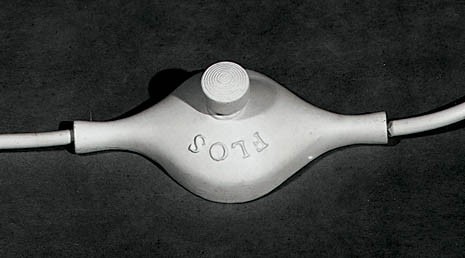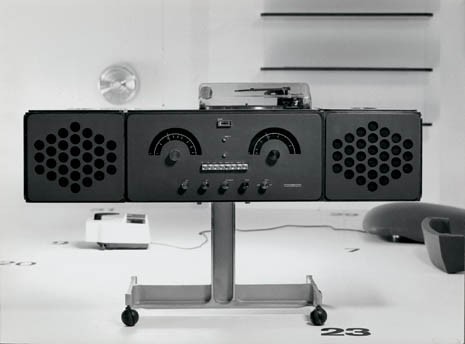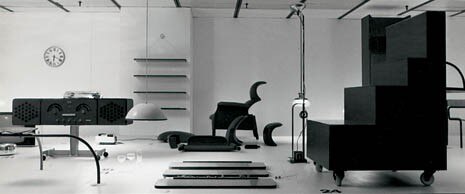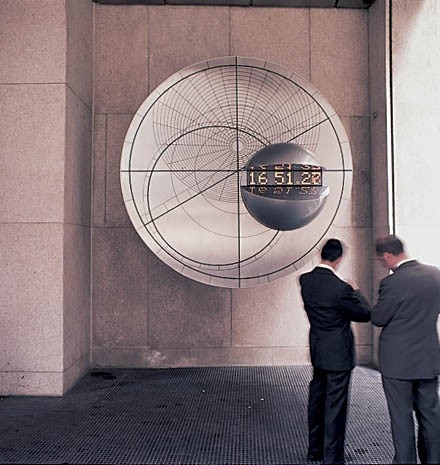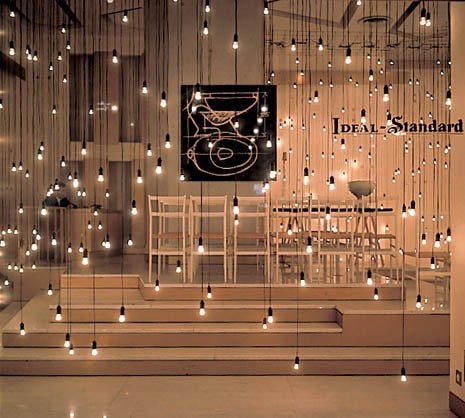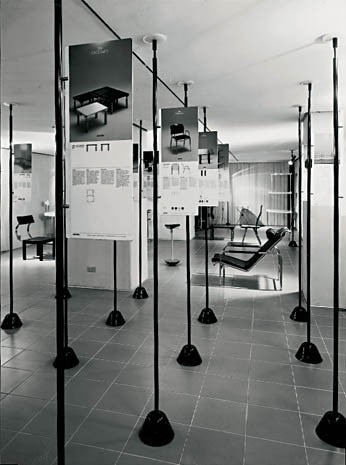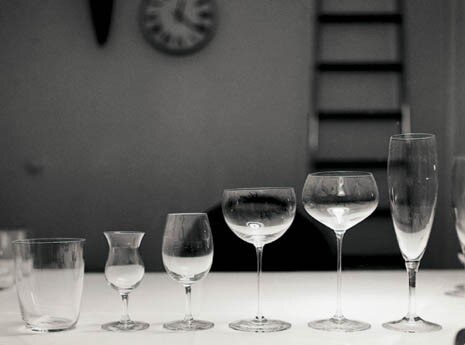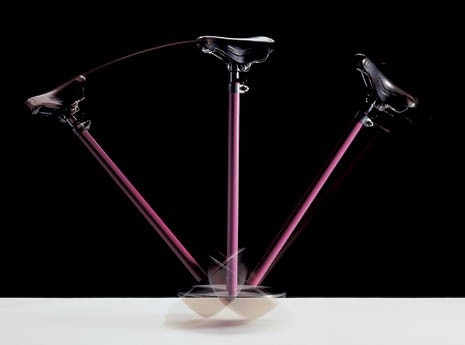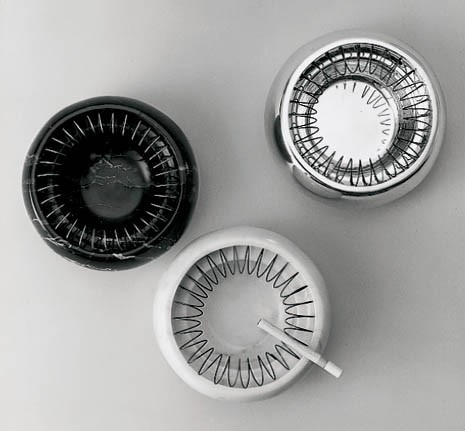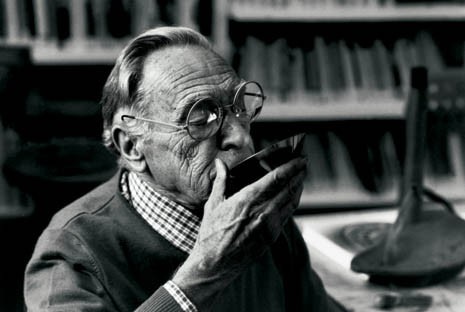Achille Castiglioni touches so many different lives: the ordinary people who buy and use the things that he designed without even knowing his name as well as the critics who try to give his objects special meaning and construct theories based on them. His gifts touch all of the industrialists, managers, clients and public officials, curators and model-makers, architects, graphic designers, artists and critics who have worked with him. He has managed to communicate his message in the workplace as well as the living room, impressing the people who actually made his products with his playful and sometimes daredevil acrobatics on the cement floors of factories and workshops.
There is no surface, no matter how humble, that Castiglioni has not negotiated and redesigned with the light step and amused smile of a man whose favourite sport in life is to test his powers of invention against the constraints of reality and thus make the most of its creative possibilities.
I don’t think I’ve ever seen him lose his temper, even in the most difficult circumstances. He might, at most, pull a wry face and make a quip, in his beloved Milanese dialect, about the absurdities of a universe that he has never ceased to love, probably because there is no other.
And yet Castiglioni also knew how to reinvent the rules that make the world work. His designs have a way of leap-frogging the laws of physics, engineering and construction. But above all, they stubbornly disobey the conventional rules of industrial production and marketing in the pursuit of more generous possibilities. When questioned about the mysteries and magic of his approach, a working method that has always produced the most appropriate, witty and beautiful designs as well as the most innovative, Castiglioni often liked to say, half jokingly, ‘The first thing to do is to forget about market research’.
These few words clear away the clutter of received wisdom that seeks to reduce the issue of designing series-manufactured products to the problem of making things ‘for the market’. Castiglioni, unlike many designers, has never been prepared to make sacrifices on that particular altar. His chief concern was that products bearing his name (if bear it they must) have a sense of universality, appealing to anyone with the slightest appreciation of the aesthetic qualities of objects and at least some functional motivation for using his products. And, for Castiglioni, motivation meant ‘need’ or even ‘real need.’ Castiglioni’s work always had in it a memory of the Bauhaus and the days when design thought it could resolve the big issues, the ‘needs’ of society and the individual.
His working method was based on the ability to identify the pivot around which a complete design can rotate. It might be a functional pivot, as in the special mallet used for driving poles into the ground in vineyards, just one of the many wonderful anonymous designs that he loved to collect, in which the object’s function dictates its weight and form. But as with the 1957 Sella stool, with its bicycle saddle as a readymade seat, that pivot could be nothing more than the impulse to engage and amuse a user. The Sella was designed as Castiglioni’s response to his own habit of rocking back and forth on his seat while on the telephone. In fact, he originally described it as a telephone stool.
Years of professional experience in a field in which approximation and chance are at least as important as conscientious planning made Castiglioni careful not to see his craft entirely as an art form, even though, in his own case, what he did could legitimately be understood as ‘art’. All of his work can, in fact be considered a process of artistic development, reflecting his intuitive skills as well as his formidable capacity to single out the forms, materials and techniques best suited to his projects, from the Toio lamp to the Mezzadro seat, from the sumptuous designs for exhibitions like Waterways from Milan to the Sea or The Other Half of the Avant-Garde, from the elegant double glasses for Danese to the humble Fischietto porcelain humidifier, one of his most recent products. But to view Castiglioni’s oeuvre only in these terms would be to diminish the significance of his lifelong devotion to teaching, first in Turin and then in Milan, and the scores of lectures he delivered all over the world.
Although these were regularly transformed into remarkable, almost ‘dumb’ performances (Castiglioni spoke only Italian, Milanese and a smattering of English and French) that sent his audiences into fits of laughter, they showed his manifest desire to communicate, at any cost and in any manner, the rational contents of his designs, or at least his distinctive attitude to design. This capacity for detachment, combined with a sharply self-critical sensibility, is among the qualities that have made Achille Castiglioni such a gifted professional and, at the same time, such a much-loved character for generations of design students. Those who were lucky enough to know him personally will never forget his kindness, helpfulness and openness. In recent years he developed an increasing impatience with the fame and following that comes with celebrity, which he found increasingly irksome.
And yet Castiglioni never gave up listening to other voices, including those with a very different viewpoint to his own: those of other designers and those of the anonymous reporters from the four corners of the globe who were welcomed into his fantastical studio, that Milanese wunderkammer in which a whiff of fog drifting across the road from the Sforza Castle mingled with the laughter of visitors unable to resist Castiglioni’s contagious good mood as he explained the workings of a crank-operated razor, one of the found objects in his collection, or rocked and chuckled on his famous Mezzadro stool while confiding the latest gossip. With the charm of a gentleman from times past, Castiglioni witnessed the transience of culture, society, inventions, technologies, ambitions and dreams of design without ever losing his sense of irony or self-mockery. For that reason one can only admire him enormously, as a person and as an artist, and deeply cherish his memory.
I have tried to use the present tense in writing about Achille Castiglioni. This is not just a linguistic device. Although we lost Castiglioni forever last December, one cannot but remember him in the same tense in which he lived, transforming the fleeting moment of creation into eternity, of language and of the continuous dialogue that, as a public artist, he never ceased to maintain with the world. He leaves behind the hundreds of objects that he designed on his own or with his brother, Pier Giacomo, an inheritance that will never allow us entirely to miss him. SC
Jasper Morrison
When I was a student, I considered Achille Castiglioni the model of an Italian designer: inventive, imaginative and poetic, transforming everyday needs into industrial reality with the maximum understanding of the power and beauty that great design can bring to ordinary things. My first visit to his studio confirmed everything I imagined of his character and more. He showed me some of the things from his collection of anonymously designed objects. One that he demonstrated personally was a small plastic film canister containing a pair of sunglasses made out of strip of 35mm Polaroid film, which I think he had found at a world’s fair in America.
One day someone must make a museum out of this collection, but for now it’s enough to remember him as he was, an all-round enthusiast whose particular vision of the world will remain with us for a very long time.
Italo Lupi
‘Function, what a beautiful form’. No phrase like this one from Achille Castiglioni could better explain Achille. The lightness, so seriously considered in all of his designs and ideas, sprang from a total lack of prejudice and expressed an ironic, paradoxical enjoyment. His agile movements, his natural elegance and buoyancy, his eternal cigarette and narrow ties, his intellectual grasp of every unconventional design process are all deeply human lessons. In style. Opportunities to work with him were great and memorable privileges. Achille always designed affection and intelligence.
Alessandro Mendini
Achille Castiglioni had a magical talent for mime. His objects themselves are a form of mimicry, just as his own person was a theatrical machine. His objects are offered to people for a playful mimicry of use.
A minimalist and a bit of a dadaist, the great Castiglioni kept his thinking far from rhetorical. He was driven not by intellectual concepts but by factual intuition and inventive virtuosity.
He designed only the indispensable, having as his first honest interlocutor the object itself. Possessing a brilliant mind that worked by synthesis, competence and experience, he was the real star, the true performing athlete of Italian design.
The design and human quality of this maestro are not to be sought in the corridors of academia, but rather admired in the equestrian circus of his projects.
Richard Sapper
Achille Castiglioni was one of the first people I met when I arrived in Milan at the end of 1957. Together with his brother, Pier Giacomo, from whom he seemed inseparable, he was someone who made a very deep impression on me. They were such true gentlemen, with such humanity, courtesy, reserve, good humour, intelligent commonsense and calmness – evidently derived from a confidence in their own professional qualities – that I said to myself: yes, of course, it must be easy to feel calm when you have so many brilliant ideas in your head.
When Pier Giacomo died, much too soon, I knew I had lost a friend who for me represented an ideal, and for that reason I felt still closer to Achille. Everybody knows he was one of the greatest designers not only in Italy but in the world. But I want to remember, too, that he was, right up to the end, a true gentleman. So I want to lay this little flower on his grave.
Ettore Sottsass
I seldom saw Castiglioni, and when I did it was usually at some private viewing or party or other such event. Sometimes we used to meet at conferences, where people talk a lot and nothing is said. We would exchange glances and smiles from a distance, as if to say: ‘What are we doing here?’
The exceptional thing about Castiglioni is that for him design, or designing, meant living. It meant discovering life little by little and, perhaps, discovering that life is so difficult, so complicated and fragile, that the only thing to do is to ask ourselves, ‘What are we doing here?’ and to smile and search in life for those places where we find ourselves more or less naked, primitive and disarmed, more or less lifted above the ground.
I seldom saw Castiglioni, but now that he is not here anymore I feel I have lost a necessary friendship, one of those relationships that illuminate life’s path.
Giulio Cappellini
Whenever I was asked who, in my opinion, was the most interesting young Italian designer, my answer was always Achille Castiglioni.
His curiosity, irony and easygoing brightness, so typical of a young person, have left a timeless mark. Achille Castiglioni never designed any product for my company, but he did design and conduct one of the most important events in its history: the Cappellini exhibition at Cologne’s Museum für Angewandte Kunst in 1996. I remember with pleasure the tremendous drive and professional energy he lavished on that project and transmitted, in the most natural way, to all those involved in it. I also remember Tom Dixon’s amused amazement when I went with him to meet the great maestro in his studio. Language was no problem: Castiglioni’s designs spoke for themselves. And now, as we go on using them in our daily lives, we realize what a marvellous legacy Achille Castiglioni has left us.
Alberto Alessi
I have learned many things from Castiglioni, ever since he came up to greet me many years ago, smiling and reflected in the large mirror that hung askew over the entrance to his workroom in his spacious office at Piazza Castello 27 in Milan. With that idiosyncratic desire – so rare among masters – to discuss matters amicably with his interlocutor, instead of seeking to impose his own personal outlook, he taught me to appreciate curiosity toward others, toward what they do and how they go about their business.
He taught me not to take myself too seriously and to be self-critical; the importance of research, in which the designer sums up the joint expressive efforts of numerous people from different backgrounds; and the fact that experience gives neither certainty nor confidence but, on the contrary, increases the possibilities of error.
As he said, it really is true that the more time passes the more difficult it becomes to design well! I have found that anecdote invaluable to my work, starting afresh each time with humility and patience. And whenever I embark on any new project, I will know that he is there.
Piero Gandini
His intellectual and moral ‘presence’ was a great refuge. And yet, though I feel alone and cold, I cannot think of him without a smile. Incomparable!
